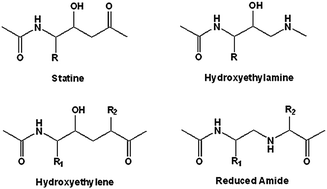Interaction mechanism exploration of HEA derivatives as BACE1 inhibitors by in silico analysis†
Abstract
The β-site amyloid precursor protein cleaving enzyme 1 (BACE1) initiates the generation of β-amyloid (Aβ) peptides which play a critical early role in the pathogenesis of Alzheimer's disease (AD), and thus it is a prime target for lowering the Aβ levels to treat AD. In the present work, a dataset of 128 promising hydroxyethylamine (HEA) derivatives as newly synthesized BACE1 inhibitors was selected to perform simulations by using 3D-QSAR, molecular docking and molecular dynamics (MD) approaches, to explore the binding mode and structural determinants required for high inhibitory potency. The resultant optimal comparative molecular similarity indices analysis (CoMSIA) model displays strong predictability (Q2 = 0.503, Rncv2 = 0.854, Rpre2 = 0.905). Docking and MD simulations demonstrate that these HEAs bind to BACE1 in a site which occupies the S1, S1′ and S2′ pockets, with a “mantodea” conformation that is mainly stabilized by the H-bond interactions. Moreover, the structural determinants of these HEA analogues are as follows: (1) the P2′ region is sensitive to the steric bulk; (2) the atom at the 2-position of the five-membered heterocyclic group (ring A) as an H-bond acceptor is conducive to the hydrogen bonding interaction, while the atom at the 6-position is detrimental; (3) introduction of the H-bond acceptor and/or donor groups into the P1′ region is crucial to the inhibitory potency improvement. These models and the derived information may help provide a better understanding of both the binding mode and specific interactions of HEA-based BACE1 inhibitors, and facilitate corresponding lead optimization and novel inhibitor design.


 Please wait while we load your content...
Please wait while we load your content...